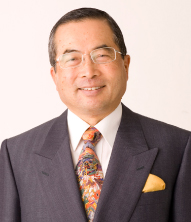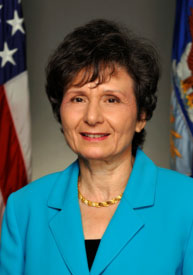KEYNOTE SPEAKERS
Tuesday, 7 December 2010 . 8:30 - 9:30

Dr. Regina E. Dugan
Director
Defense Advanced Research Projects Agency (DARPA), USA
Appointed by Secretary of Defense, Robert M. Gates, and announced by the Director, Defense Research and Engineering, Zachary Lemnios, Dr. Regina E. Dugan was sworn in as the 19th director of the Defense Advanced Research Projects Agency (DARPA) on July 20, 2009. Founded in 1958 as a response to the Soviet Union’s launch of Sputnik, DARPA’s mission is to preventهstrategic surprise for the United States as well as create strategic surprise for our adversaries. From its founding more than 50 years ago to current day, this mission implies one imperative for the Agency: radical innovation for national security. Today DARPA is the principal agency within the Department of Defense for research, development and demonstration of high-risk, high-payoff projects for the current and future combat force.
ه
Experienced in counterterrorism and defense against explosive threats, Dr. Dugan first served the Nation as a DARPA program manager from 1996 to 2000. During this first tour with the Agency, she directed a diverse $100 million portfolio of programs including the “Dog’s Nose” program, an effort focused on the development of an advanced, field-portable system for detecting the explosive content of land mines. In 1999, Dr. Dugan was named DARPA Program Manager of the Year for her efforts, and in 2000 she was awarded the prestigious Bronze deFleury medal by the Army Engineer Regiment. She is also the recipient of the Office of the Secretary of Defense Award for Exceptional Service and the Award for Outstanding Achievement.
Dr. Dugan’s contributions to the United States military are numerous. She led a counterterrorism task force for the Deputy Secretary of Defense in 1999 and, from 2001 to 2003, she served as a special advisor to the Vice Chief of Staff of the Army, completing a Quick Reaction Study on Countermine for Enduring Freedom. The results of this study were subsequently briefed to joint senior military leadership and successfully implemented in the field.
Prior to her appointment as director of DARPA, Dr. Dugan co-founded Dugan Ventures, a niche investment firm, where she served as President and CEO. In 2005, Dugan Ventures founded RedXDefense, LLC, a privately held company devoted to innovating solutions for combating explosive threats, where she also served as President and CEO. From private industry, Dr. Dugan brings a wealth of management, finance, product development, and marketing experience to the Agency.
Widely recognized for her leadership in technology development and as an experienced public speaker, Dr. Dugan has appeared on the Discovery Channel, National Public Radio, and The AAAS Science Report. Her projects have been the subject of articles in The New York Times Science Times, The New York Times Circuits, Forbes, The Wall Street Journal, Chemical and Engineering News and Science News. Additionally, Dr. Dugan previously participated in wide-ranging studies for the Defense Science Board, Army Science Board, National Research Council, and the Science Foundation, and sat on the Naval Research Advisory.
Dr. Dugan obtained her doctorate degree in mechanical engineering from the California Institute of Technology and her master’s and bachelor’s degrees from Virginia Tech. She is the sole inventor or co-inventor on multiple patents and patents pending. Dr. Dugan is the co-author of Engineering Thermodynamics, 1996. She is the first female director of DARPA.
Wednesday, 8 December 2010 . 8:30 - 9:30ه 
Dr. Sachio Semmoto
Founder & Chairman, Representative Director, eAccess Ltd.
Founder & Chairman, Representative Director, EMOBILE Ltd.
Title: "Creative Destruction" in Broadband eAccess Ltd. was started by only 2 persons in 1999 focussing on ADSL wholesale service. The activities of such venture companies contributed largely to the emergence of broadband when ISDN was the future of telecommunication technologies. Today, the fixed broadband infrastructure of Japan has dramatically improved approaching nearly 65% household penetration.
ه
In 2007, EMOBILE launched Japan’s first flatrate mobile broadband service. The success of this flat rate pricing for unlimited usage with serious competition among new comers and incumbent operators has contributed to the development of this market.
ه
The speech focuses on how the telecommunication market in Japan was transitioned from a PSTN environment to a broadband market by the challenges of venture companies.
Bio:
Dr. Semmoto founded eAccess Ltd in 1999. eAccess is Japan’s first true entrepreneurial and global IP/telecom company that provides high-speed broadband telecommunication services using xDSL technology. eAccess has grown to a leading broadband IP operator in Japan, and completed its Initial Public Offering at the Tokyo Stock Exchange Mothers in October 2003 and moved to the Tokyo Stock Exchange First Section (TSE1) in November 2004. This is considered to be the fastest listing in the TSE1 whose market capitalization was approximately US$1.5 billion.
Additionally he founded EMOBILE Ltd. which was awarded 3G spectrum license in 2005 andه entered into the mobile broadband market in 2007. EMOBILE completed its financing, total US$4.4 billion, which includes $1.7 billion for equity and $2.7 billion for debt financing, to roll out the nationwide mobile network. EMOBILE launched its data service in March 2007 and then the voice service in March 2008. EMOBILE’s high speed, flat rate and reasonable pricing mobile data communications service dramatically changed the existing mobile scene, creating a “broadband revolution” in the mobile industry.
Prior to eAccess, Dr. Semmoto spent 30 years in senior management positions including Nippon Telephone & Telegraph (NTT), Kyocera, and DDI Corporation (currently “KDDI”) which he co-founded as an Executive Vice President in 1984. At NTT, he developed the first optical fiber system in Japan and led the development of the Information Network System, the world’s first digital service which embodied the ISDN concept. He was Japan’s official representative to the ITU on optical fiber and ISDN (1974-1980). He played a major role in bringing DDI up to $6 billion in sales and $760 million in profit after 7 years of operation. In 1990, he founded DDI cellular group (currently “au”) as an intrapreneur. Subsequently in 1995, he founded DDI Pocket, a PHS company (currently “WILLCOM”), and became the first president.
In 1996, Dr. Semmoto became a full professor at the Graduate School of Business Administration, Keio University to teach in the areas of entrepreneurial management and information technology, prior to the establishment of eAccess Ltd. Although he spent most of his career in the telecommunication industry, he has also had a background of academic involvement through extensive lecturing engagements at the world’s leading universities, including Harvard, Stanford, Northwestern, Cambridge in the U.S. and the UK. He was a visiting professor at the Carnegie Mellon University and at the Haas School of Business at University of California Berkeley during 1992-1993 and 2000-2001, respectively, and a visiting research fellow at Stanford University in 1997.
Dr.Semmoto is a Fellow of the IEEE. He is a director and the board of Thomson Reuters Founders Share Company (London, UK), International Christian University (ICU) (Tokyo, Japan), and a member of the Network of Global Agenda Councils, World Economic Forum and the Trilateral Commission. He is a member of Royal Swedish Academy of Engineering Sciences. He serves Vice President of Fulbright Association in Japan. He published numerous academic papers and books on both telecommunication technologies and high technology corporate management.
He graduated from Kyoto University, Japan and received his MS and Ph.D. of Electrical Engineering in University of Florida.
Thursday,ه9 December 2010 . 8:30 - 9:30ه

Dr. Frederica Daremaه (IEEE Fellow, WAS Fellow)
Director, Air Force Office of Scientific Research, USA
Title: On Network Science
In recent years there has been an emerging interest for more systematic study and analysis of networked systems and an attempt to understand and establish universal fundamental principles governing the behavior, characterization and representation of network systems. Establishing such fundamental principles and underpinnings would give rise to the field of Network Science.ه Understanding and developing such foundational capabilities is not only intellectually appealing, but can also have important practical applications, for example in exploiting capabilities and mechanisms manifested in certain network systems and applying them to enable or enhance capabilities in other network systems. The talk will discuss examples of several classes of networked systems from engineered, to biological and to societal systems, and will address possible principles and ideas that can be explored. Dr. Darema, a member of the Senior Executive Service, is the Director of the Mathematics, Information and Life Sciences Directorate at the Air Force Office of Scientific Research, Arlington, Va. She provides executive direction in the planning, conduct and coordination of broad, frequently large-scale and critical basic research and development program activities in such areas as advanced mathematical and computational methods for dynamic systems, information and decision systems, bio-systems, human cognition and socio-cultural systems.ه
Bio:
Dr. Darema is a graduate of the University of Athens, Greece, the Illinois Institute of Technology and the University of California at Davis, where she attended the latter two as a Fulbright Scholar and a Distinguished Scholar.ه After physics research associate positions at the University of Pittsburgh and Brookhaven National Laboratory, she received an American Physics Society (APS) Industrial Fellowship and became a technical staff member in the Nuclear Sciences Department at Schlumberger-Doll Research. Subsequently, she joined the International Business Machines Corporation T. J. Watson Research Center as a research staff member in the Computer Sciences Department and later she established and became the manager of a research group at IBM Research on parallel applications. While at IBM, she also served in the IBM Corporate Strategy Group examining and helping to set corporate-wide strategies.ه From 1996�1998, she completed a two-year assignment at the Defense Advanced Research Projects Agency (DARPA) where she initiated a new thrust for research on methods and technology for performance-engineered systems. Dr. Darema has given numerous keynotes and other invited presentations in professional forums.㺡 Most recently Dr. Darema has held executive level positions at the National Science Foundation (NSF) as Senior Science and Technology Advisor and Senior Science Analyst in the Computer and Information Science and Engineering Directorate.Dr. Darema was elected as an Institute of Electrical and Electronics Engineers (IEEE) Fellow for proposing the Single-Program-Multiple-Data (SPMD) computational model that has become the predominant model for programming parallel and distributed computers.㺡 Dr. Darema's interests and technical contributions span the development of parallel applications, parallel algorithms, programming models, environments and performance methods and tools for the design of applications and of software for parallel and distributed systems. At NSF, Dr. Darema developed initiatives and programs that changed the landscape of computer science research and included novel research directions in systems software and the Dynamic Data Driven Applications Systems (DDDAS) paradigm. She also led initiatives on research at the interface of neurobiology and computing, and other across-departmental and cross-agency initiatives such as the Information Technology Research and Nanotechnology Science and Engineering Initiative, the Scalable Enterprise Systems Initiative and the Sensors Programs Initiative.
㺡 㺡 |
